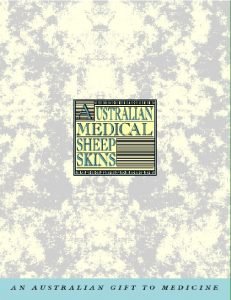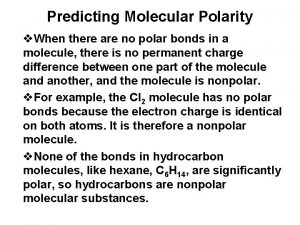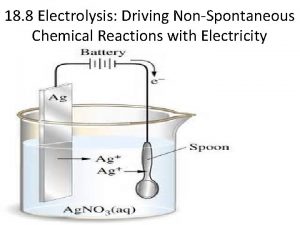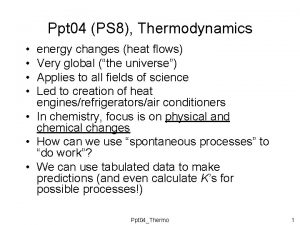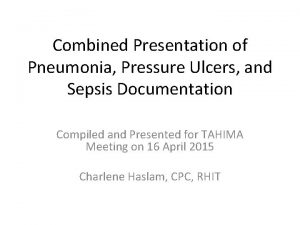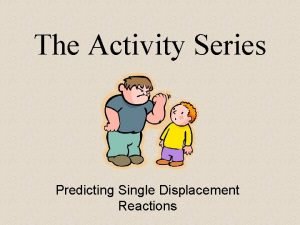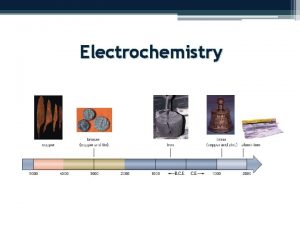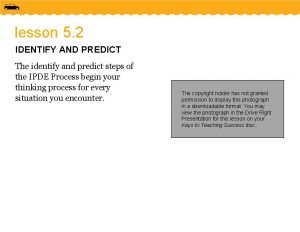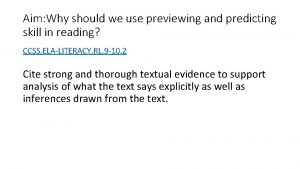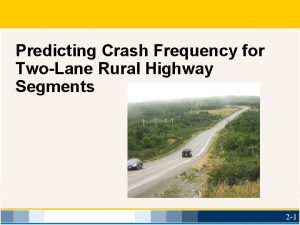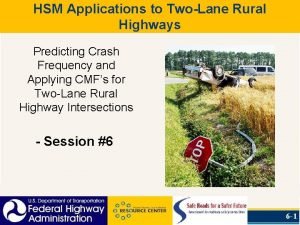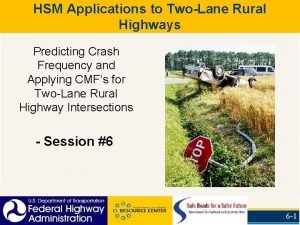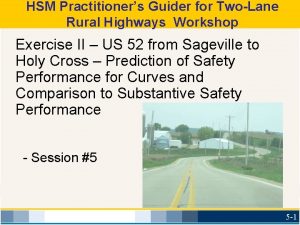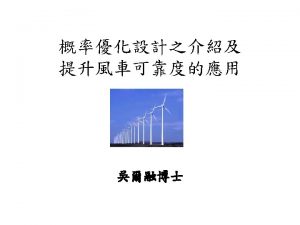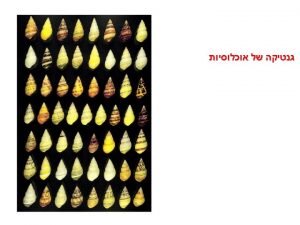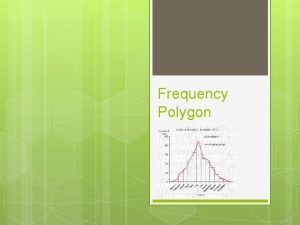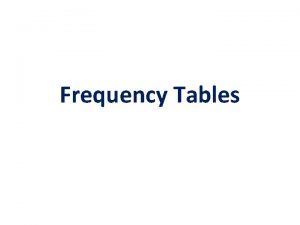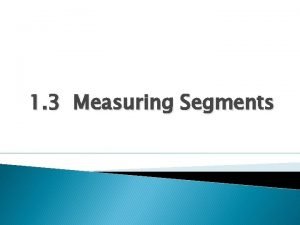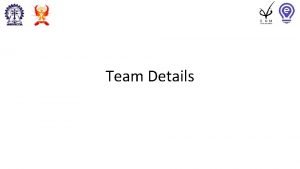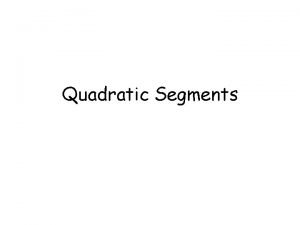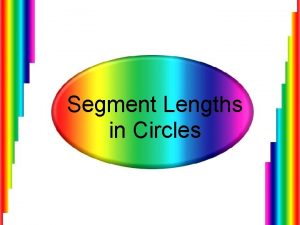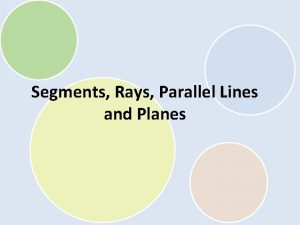Predicting Crash Frequency for TwoLane Rural Highway Segments









































































- Slides: 73

Predicting Crash Frequency for Two-Lane Rural Highway Segments 2 -1

Predicting Crash Frequency for Two-Lane Rural Highway Segments Learning Outcomes: ► Describe the Safety Performance Functions (SPFs) for predicting Crash Frequency for Base Conditions ► Describe the Quantitative Safety Effects of Crash Modification Factors (CMFs) ► Apply CMFs to the SPF Base Equation 2 -2

Predicting Crash Frequency for Two-Lane Rural Highway Segments Cross Sectional Elements 2 -3

Two-Lane Rural Highway Segments What should you expect would be the safety and operational influence of cross sectional elements? Crashes Operations Head-on Capacity Lane Width Wider is “better” Wider means “faster” Shoulder Width Sideslope Clear Zone Run-off-Road Wider is “better” Run-off-road (severity) Flatter is better Run-off-road (frequency and severity) Capacity Functionality (peds, bikes, emergency stops, capacity, maintenance) Maintenance Flatter is better Horizontal sight distance 2 -4

Two-Lane Rural Highway Segments Functions of shoulders in a rural environment q. Clear zone (recovery) q. Highway Capacity q. Clear zone (horizontal sight distance) q. Store vehicles in emergency q. Pedestrians, bicyclists q. Protection for turns off the roadway q. Provide pavement support q. Store snow q. Provide space for maintenance activities q. Enforcement activities 2 -5

Two-Lane Rural Highway Segments Key Findings of FHWA Cross Section Study on Two-Lane Hwys (Zegeer) ► Traffic volume influences crash rate ► Both lane and shoulder width have influence ► Roadside Hazard next biggest influence on crashes ► Alignment affects cross section crashes (terrain is surrogate for alignment) 2 -6

Two-Lane Rural Highway Segments Crash Severity for Two-Lane Rural Highways Rural 2 Lane Highway Segment Severity Ratio = 32. 1% for Injury + Fatal Crashes 2 -7

2 -8

HSM Crash Prediction: 18 Steps for Two-Lane Rural Roadways Rural Area Definition: • Places outside urban boundaries • Populations of 5, 000 persons, or less Applicable to: • Existing Roadways • Design Alternatives for existing or new roadways 2 -9

Predicting Crash Frequency Performance - Analysis Sections Organizing information for Safety Analysis: ► Separate project lengths (and crashes) into homogeneous units: • Average daily traffic (AADT) volume (vehicles/day) • Lane width (ft) • Shoulder Type • Driveway Density (driveways per mile) • Roadside Hazard Rating • Beginning/End of Horizontal Curves • Beginning/End of Segments on Grade (>3%) 2 -10

Subdividing Roadway Segments Homogeneous Roadway Segments: Lane Width 2 -11

Subdividing Roadway Segments Homogeneous Roadway Segments: Shoulder Width 2 -12

HSM Crash Prediction Method Three Basic Elements: 1. Safety Performance Functions (SPF) Equations ►Predict safety performance for set base conditions 2. Crash Modification Factors (CMFs) ►Adjust predicted safety performance from base conditions to existing/proposed conditions ►Are greater or less than 1: q < 1. 0 -- lower crash frequency q > 1. 0 -- increased crash frequency 3. Calibration, Cr or Ci ►Accounts for local conditions/data 2 -13

HSM Crash Prediction Method Total estimated crashes within the limits of the roadway being analyzed: Ntotal = ∑Npredicted-rs + ∑ Npredicted-int Ntotal = Total expected number of crashes within the limits of the roadway facility ∑Npredicted-rs = Expected crash frequency for all roadway segments (sum of individual segments) ∑ Npredicted-int = Expected crash frequency for all intersections (sum of individual intersections) 2 -14

Roadway Segment Prediction Model Npredicted-rs = Nspf-rs x (CMF 1 r … CMFxr) Cr Where: Npredicted-rs = predicted average crash frequency for an individual roadway for a specific year (crashes per year) Nspf-rs = predicted average crash frequency for base conditions for an individual roadway segment (crashes per year) CMF 1 r. . . CMFxr = Crash Modification Factors for individual design elements Cr = calibration factor 2 -15

Safety Performance Function (SPF) SPF for Two-Lane Rural Highway Segment Crashes for Base Conditions: Nspf-rs = (AADTn) (L) (365) (10 -6) e-0. 312 Where: Nspf-rs = predicted total crash frequency for a roadway segment for base conditions, crashes per year AADTn = average annual daily two-way traffic volume for specified year n (veh/day) L = length of roadway segment (miles) 2 -16

Base Conditions for Rural Two-Lane Roadway Segments (CMF = 1. 0) ► Lane Width: 12 feet ► Shoulder Width: 6 feet ► Shoulder Type: Paved ► Roadside Hazard Rating: 3 ► Driveway Density: <5 driveways/mi ► Grade: <3%(absolute value) ► Horizontal Curvature: None ► Vertical Curvature: None ► Centerline rumble strips: None ► TWLTL, climbing, or passing lanes: None ► Lighting: None ► Automated Enforcement: None 2 -17

Safety Performance Function (SPF) Applying SPF for Base Conditions – Example: Nspf-rs = (AADTn) (L) (365) (10 -6) e-0. 312 2 -lane state highway connecting a US marked route to a primary State marked route in a rural county; Where: AADT = 3, 500 vpd Length = 26, 485 feet = 5. 02 miles 2 -18

Safety Performance Function (SPF) Applying SPF for Base Conditions – Example: Where: AADT = 3, 500 vpd Length = 26, 485 feet = 5. 02 miles Nspf-rs = (AADTn) (L) (365) (10 -6) e-0. 312 Nspf-rs = (3, 500) (5. 02) (365) (10 -6) e-0. 312 = (3, 500) (5. 02) (365) (10 -6) (0. 7320) = 4. 69 crashes per year 2 -19

Applying CMF’s for Conditions other than “Base” Next Step is: Npredicted-rs = Nspf-rs x (CMF 1 r … CMFxr) Cr Where: ► Npredicted-rs = predicted average crash frequency for an individual roadway for a specific year (crashes per year) ► Nspf-rs = predicted average crash frequency for base conditions for an individual roadway segment (crashes per year) ► CMF 1 r. . . CMFxr = Crash Modification Factors for individual design elements ► Cr = calibration factor 2 -20

Crash Modification Factors (CMFs) ► CMFs quantify the expected change in crashes at a site caused by implementing a particular treatment, countermeasure, intervention, action, or alternative. ► CMFs are used to adjust the SPF estimated predicted average crash frequency for the effect of individual geometric design and traffic control features. 2 -21

Crash Modification Factors (CMFs) Applying CMFs for Lane Width, Shoulder Width & Type, Driveway Density, TWTLs, and Roadside Design Nspf-rs = (AADTn) (L) (365) (10 -6) e-0. 312 Npredicted-rs = Nspf-rs(CMF 1 r x CMF 2 r x CMF 6 r x CMF 9 r x CMF 10 r) Where: CMF 1 r is for Lane Width CMF 2 r is for Shoulder Width and Type CMF 6 r is for Driveway Density CMF 9 r is for Two-Way Left-Turn Lanes CMF 10 r is for Roadside Design 2 -22

Rural Two-Lane Highway Segment CMFs 2 -23

Crash Modification Factor for Lane Width (CMF 1 r) CMF 1 r = (CMFra – 1. 0)pra + 1. 0 CMFra for lane width 1. 23 • ‘Base condition’ is 12 ft lanes • CMFs for ADT >2000 based on Zegeer • CMFs for ADT <400 based on studies by Griffin and Mak • Expert panel developed transition lines, referencing other research 2 -24

Crash Modification Factor for Lane Width (CMF 1 r) CMF 1 r = (CMFra – 1. 0)pra + 1. 0 Note equations for ADT’s between 400 and 2000 2 -25

CMF - Lane and Shoulder Width Adjustment for Related Crashes Table 10 -4 - Adjust for (Run off Road + Headon + Sideswipes) to total crashes pra = 0. 574 CMF 1 r = (CMFra – 1. 0)pra + 1. 0 2 -26

Calculation for Lane Width (CMF 1 r): Example For 3, 500 AADT for a 10 foot wide lane: From Table 10 -8: CMFra = 1. 30 ► Adjustment for lane width and shoulder width related crashes (Run off Road + Head-on + Sideswipes) to obtain total crashes using default value for pra = 0. 574 CMF 1 r = (CMFra - 1. 0) pra + 1. 0 = (1. 30 - 1. 0) * 0. 574 + 1. 0 = (0. 30) (0. 574) + 1. 0 = 1. 172 2 -27

Calculation for Shoulder Width and Type (CMF 2 r) CMF 2 r = (CMFwra CMFtra– 1. 0)pra + 1. 0 CMFwra for shoulder width: • Base condition is 6 -ft shoulders • CMFs for ADT >2000 based on Zegeer (FHWA) • CMFs for ADT <400 based on other studies by Zegeer (NCHRP 362) • Expert panel developed transition lines, referencing other research 2 -28

Crash Modification Factor for Shoulder Width (CMFwra) CMF 2 r = (CMFwra CMFtra– 1. 0)pra + 1. 0 Note equations for ADT’s between 400 and 2000 2 -29

Crash Modification Factor for Shoulder Type (CMFtra) 2 -30

CMF – Lane and Shoulder Width Adjustment for Related Crashes Table 10 -4 - Adjust for (Run off Road + Headon + Sideswipes) to total crashes pra = 0. 574 CMF 2 r = (CMFwra. CMFtra – 1. 0)pra + 1. 0 2 -31

Calculation for Shoulder Width and Type (CMF 2 r): Example For 3, 500 AADT with a 2 ft wide aggregate shoulder: CMFwra = 1. 30 (Table 10 -9) and CMFtra = 1. 01 (Table 10 -10) ► Adjustment from crashes related to lane and shoulder width (Run off Road + Head-on + Sideswipes) to total crashes using default value for pra = 0. 574 CMF 2 r = (CMFwra CMFtra - 1. 0) pra + 1. 0 = ((1. 30)(1. 01) - 1. 0) * 0. 574 + 1. 0 = (0. 313) (0. 574) + 1. 0 = 1. 180 2 -32

Crash Modification Factors Lane and Shoulder Width – Example: For 1, 500 AADT 10’ lane and no shoulder: What is CMF 1 r&2 r? q Lane Width = 10’ (From Table 10 -8) CMFra = 1. 213 CMF 1 r = (1. 213 - 1. 0)x 0. 574 + 1. 0 = 1. 122 q Shoulder Width = 0’ (From Table 10 -9) Combined CMF: CMFwra = 1. 375 CMF 1 r&2 r = 1. 122 x 1. 215 CMF 2 r= (((1. 375 x 1. 00) = 1. 363 1. 0)x 0. 574) + 1. 0 = 1. 215 2 -33

Crash Modification Factors Example: Combination Shoulder Type 6 ft Shoulder, AADT > 2, 000 vpd From Table 10 -10: • CMF 6’ paved = 1. 00 • CMF 6’ gravel = 1. 02 6 ft 4’ 2’ q Combination Shoulder Type CMFtra Calculation: Ø CMFtra = (4’/6’)x 1. 00 + (2’/6’) x 1. 02 = 1. 007 2 -34

Some Insights Review of CMFs for Lane Width and Shoulders ► Not much difference between 11 and 12 -ft lanes ► Lane width is less important for very low volume roads ► Incremental width for shoulders is much more sensitive than for lanes ► Shoulder width effectiveness increases significantly as AADT increases 2 -35

CMF for % Grade for Roadway Segments (CMF 5 r) For Roadway Segment on 4% Grade: CMF 5 r = ? 1. 10 2 -36

CMF for Driveway Density (Access) (CMF 6 r) 0. 322 + (0. 05 -0. 005 Ln(AADT))*DD ___________ CMF 6 r = 0. 322 + (0. 05 -0. 005*Ln(AADT))*5 Where: CMF 6 r = effect of driveway density on total crashes DD = Driveway Density (driveways per mile) AADT = Average Annual Daily Traffic 2 -37

Calculation for Driveway Density (CMF 6 r): Example Where: AADT = 3, 500 Access is 31 driveways in 5. 02 miles DD = 31/5. 02 = 6. 17 driveways per mile CMF 6 r = = 0. 322 + (0. 05 -0. 005*Ln(AADT))*DD ___________ 0. 322 + (0. 05 -0. 005*Ln(AADT))*5 0. 322 + (0. 05 -0. 005*Ln(3, 500))*6. 17 0. 322 + (0. 05 -0. 005*Ln(3, 500))*5 = 1. 029 2 -38

CMF for Installing Centerline Rumble Strips (CMF 7 r) 2 -39

Safety Effects of Installing Shoulder Rumble Strips: Two-Lane Rural Roads * Not in HSM *CRFrumble = 13% reduction in total crashes CMF = 1 – *CRF CMFrumble = 1 - 0. 13 = 0. 87 *From FHWA CMF Clearinghouse http: //www. cmfclearinghouse. org 2 -40

CMF for Passing Lane/Climbing Lane (CMF 8 r) 2 -41

CMF for Rural Two-Way Left Turn Lanes (CMF 9 r) Most effective where one direction flow rate > 300 vph and in rural areas 2 -42

CMF for TWLTL Lanes (CMF 9 r) CMF 9 r = 1. 0 – 0. 7 PD * PLT/D Where: Pdwy = Driveway-related crashes as a proportion of total crashes Pdwy = (0. 0047 DD + 0. 0024 DD 2) (1. 199 + 0. 0047 DD + 0. 0024 DD 2) DD = drive density (driveways/mi > 5/mile) PLT/D = Left turn crashes susceptible to correction by a TWLTL as a proportion of driveway related crashes (estimated as 0. 50) 2 -43

Example Calculation for TWLTL (CMF 9 r) CMF 9 r = 1. 0 – (0. 7 Pdwy x PLT/D) For 35 driveways in 0. 8 mile long segment DD = 35/0. 8 = 43. 47 driveways/mi Pdwy = (0. 0047(43. 47)) + 0. 0024(43. 472) (1. 199 + 0. 0047(43. 47) + 0. 0024(43. 472) = 0. 80 CMF 9 r = 1. 0 – (0. 7 x 0. 80 x 0. 50) = 0. 72 2 -44

Roadside Quality is Strongly Linked to Related Crashes Roadside Design (CMF 10 r) Roadside Design is based on Roadside Hazard Ratings that are dependent on the roadside environment Ratings range from 1 to 7: • 1 = forgiving roadside environment • 7 = unforgiving roadside environment 2 -45

Roadside Hazard Ratings Base condition is Hazard Rating = 3 2 -46

Roadside Hazard Rating of 1 ► Wide clear zones greater than or equal to 30 ft from the pavement edgeline. ► Sideslopes flatter than 1: 4 ► Recoverable sideslope 2 -47

Roadside Hazard Rating of 2 4 1 ► Clear zone between 20 and 25 ft from pavement edgeline ► Sideslope about 1: 4 ► Recoverable sideslope 2 -48

Roadside Hazard Rating of 3 3 1 ► Clear zone about 10 ft from pavement edgeline ► Sideslope about 1: 3 or 1: 4 ► Rough roadside surface ► Marginally recoverable 2 -49

Roadside Hazard Rating of 4 ► Clear zone between 5 and 10 ft from pavement edgeline ► Sideslopes about 1: 3 or 1: 4 ► May have guardrail (5 to 6. 5 ft from pavement edgeline). ► May have exposed trees, poles, or other objects (about 10 ft from pavement edgeline) ► Marginally forgiving, but increased chance of a reportable roadside crash 2 -50

Roadside Hazard Rating of 5 ► Clear zone between 5 and 10 ft from pavement edgeline ► Sideslope about 1: 3 ► Virtually nonrecoverable ► May have guardrail (0 to 5 ft from edgeline) ► May have exposed trees, poles, or other objects (about 10 ft from pavement edgeline) 2 -51

Roadside Hazard Rating of 6 2 1 ► Clear zone less than or equal to 5 ft ► Sideslope about 1: 2, Non-recoverable ► No guardrail ► Exposed rigid obstacles within 0 to 6. 5 ft of the pavement edgeline 2 -52

Roadside Hazard Rating of 7 ► Clear zone less than or equal to 5 ft ► Sideslope 1: 2 or steeper, Non-recoverable ► Cliff or vertical rock cut ► No guardrail ► High likelihood of severe injuries from a roadside crash 2 -53

CMF for Roadside Hazard Rating for Roadside Design (CMF 10 r) CMF 10 r = e(-0. 6869 + (0. 0668 x RHR)) e(-0. 4865) Where: CMF 10 r = CMF for the effect of roadside design RHR = Roadside Hazard Rating 2 -54

Calculation for Roadside Design (CMF 10 r): Example Where: RHR = 5 CMF 10 r = e(-0. 6869 + (0. 0668 x. HR)) /e-0. 4865 = e(-0. 6869 + (0. 0668 x 5)) /e-0. 4865 = 1. 143 2 -55

Calculated CMFs for Roadside Hazard Ratings HAZARD RATING CMF'S (calculated) Clear zone width Roadside Obstacles (ft) Roadside Slope Hazard Rating CMF 10 r None within clear Zone 30 or more Flatter than 1: 4 1 0. 875 None within clear Zone 30 or more 1: 4 1. 5 0. 905 None within clear Zone 20 to 30 1: 4 2 0. 935 None within clear Zone 20 to 30 1: 3 2. 5 0. 967 None within clear Zone 10 to 20 1: 4 2. 5 0. 967 None within clear Zone 10 to 20 1: 3 3 1. 000 None within clear Zone 10 to 20 1: 2 or steeper 3. 5 1. 034 None within clear Zone 5 to 10 1: 4 4 1. 069 None within clear Zone 5 to 10 1: 3 5 1. 143 None within clear Zone 5 to 10 1: 2 or steeper 5. 5 1. 182 None within clear Zone 0 to 5 N/A 6 1. 222 Barrier 5 -6. 5 ft fro edge of travel way None N/A 4 1. 069 Barrier 0 -5 ft from edge of travel way None N/A 5 1. 143 Rock cut or cliff with no barrier None N/A 7 1. 306 2 -56

CMF for Lighting (CMF 11 r) CMF 11 r = 1. 0 – [(1. 0 – 0. 72 pinr – 0. 83 ppnr ) pnr] Where: CMF 11 r = effect of lighting on total crashes ► pinr = proportion of total nighttime crashes for unlighted roadway segments that involve a fatality or injury ► ppnr = proportion of total nighttime crashes for unlighted roadway segments that involve PDO crashes only ► pnr = proportion of total crashes for unlighted roadway segments that occur at night 2 -57

CMF for Lighting CMF 11 r = 1. 0 - [(1. 0 – 0. 72 pinr – 0. 83 ppnr ) pnr ] ► These are default values for nighttime crash proportions; replace with local values if available 2 -58

Calculation for Lighting (CMF 11 r) for Total Crashes Example: Two-Lane Undivided: Obtaining coefficients from Table 10 -12 CMF 11 r = 1. 0 - [(1. 0 – 0. 72 pinr – 0. 83 ppnr ) pnr ] CMF 11 r = 1. 0 – [(1. 0 – 0. 72(0. 382) – 0. 83(0. 618))(0. 370)] = 1. 0 – [(1. 0 – 0. 275 – 0. 513)(0. 370)] = 1. 0 - (0. 212)(0. 370) = 0. 922 2 -59

CMF for Lighting for Nighttime Crashes 2 -60

Safety Effects of Automated Speed Enforcement (CMF 12 r) Use of video or photographic identification in conjunction with radar or lasers to detect speeding drivers: CMF 12 r = 0. 93 for Total Crashes 2 -61

CMFs of Other Roadway Elements ►*Horizontal Curves & Superelevation ►Flattening Side Slopes ►Centerline Pavement Markings ►Edgeline Pavement Markings ►Post Mounted Delineators ► Installing Combination Horizontal/Advisory Speed Signs ► Raised Pavement Markers 2 -62

CMF for Flattening Sideslopes for Total Crashes 2 -63

CMF for Flattening Sideslopes for Single Vehicle Related Crashes 2 -64

Safety Effects of Placing Standard Edgeline Markings ► combining Injury (32. 1%)and Non-Injury (67. 9%) into an CMF for total crashes: CMFedgeline = 0. 97*0. 321 + 0. 97*0. 679 = 0. 97 2 -65

CMF for Placing Standard Centerline Markings ► combining Injury (32. 1%)and Non-Injury (67. 9%) into an CMF for total crashes: CMFcenterline = 0. 99*0. 321 + 1. 01*0. 679 = 1. 004 2 -66

CMF for Placing Standard Centerline and Edgeline Markings ► using Injury (32. 1%)and Non-Injury (67. 9%) into an CMF for total crashes: CMFcenterline+Edge = (CMF-1. 0) x 0. 321 + 1 = (0. 76 -1. 0) x 0. 321 + 1 = 0. 923 2 -67

CMF for Placing Standard Centerline and Edgeline Markings and Post Mounted Delineators ► using Injury (32. 1%)and Non-Injury (67. 9%) into an CMF for total crashes: CMFcenterline+Edge+Del = (CMF-1. 0) x 0. 321 + 1 = (0. 55 -1. 0) x 0. 321 + 1 = 0. 856 2 -68

Applying CMFs to the SPF Base Prediction Model Npredicted-rs = Nspf-rs x (CMF 1 r x…CMFxr) Cr Where: Npredicted-rs = predicted average crash frequency for an individual roadway for a specific year (crashes/year) Nspf-rs = predicted average crash frequency for base conditions for an individual roadway segment (crashes per year) CMF 1 r. . . CMFxr = Crash Modification Factors for individual design elements Cr = calibration factor 2 -69

Applying CMFs to the SPF Base Prediction Model: Example From Example Calculations: Rural Two-Lane Road: AADT = 3, 500 vpd, Length = 5. 02 mi, 31 Driveways, RHR = 5, Nspf-rs = 4. 69 Lane Width = 10 ft CMF 1 r = 1. 172 Shoulder Width = 2 ft gravel CMF 2 r = 1. 180 Segments on Grade (none) CMF 5 r = 1. 000 Driveway Density (6. 17/mi) CMF 6 r = 1. 029 Centerline Rumble, None CMF 7 r = 1. 000 Edgeline Rumble CMF 7 re = 0. 870 Passing/Climbing Lanes, None CMF 8 r = 1. 000 TWLTLs, None CMF 9 r = 1. 000 Roadside Design, RHR = 5 CMF 10 r = 1. 143 Lighting, None CMF 11 r = 1. 000 Automated Enforcement, None CMF 12 r = 1. 000 2 -70

Applying CMFs to the SPF Base Prediction Model: Example Npredicted-rs = Nspf-rs x (CMF 1 rx … CMFxr) Cr From example calculations (letting Cr = 1. 0): Npredicted-rs = 4. 69 x (1. 172 x 1. 180 x 1. 000 x 1. 029 x 1. 00 x 0. 870 x 1. 000 x 1. 143 x 1. 000) x 1. 000 = 4. 69 x 1. 415 = 6. 64 crashes per year 2 -71

Predicting Highway Safety for Two-Lane Rural Highway Segments Learning Outcomes: ► Described the Safety Performance Function (Base) equation for prediction of Crash Frequency ► Described the Quantitative Safety Effects of Crash Modification Factors (CMFs) ► Applied CMFs to the Base Equation 2 -72

HSM Practitioner’s Guide for Two-Lane Rural Highways Workshop Questions and Discussion: 2 -73
 Marginal relative frequency
Marginal relative frequency Relative frequency bar chart
Relative frequency bar chart Probability with relative frequency
Probability with relative frequency Marginal frequency distribution
Marginal frequency distribution Power of sine wave
Power of sine wave Conditional relative frequency definition
Conditional relative frequency definition Vmax = aw
Vmax = aw Braden scale for predicting pressure sore risk
Braden scale for predicting pressure sore risk Predicting molecular polarity
Predicting molecular polarity Predicting products
Predicting products Predicting products of chemical reactions
Predicting products of chemical reactions Predicting single replacement reactions
Predicting single replacement reactions Predicting fraud
Predicting fraud Activity series of metals
Activity series of metals Predicting products of electrolysis
Predicting products of electrolysis Predicting spontaneity
Predicting spontaneity Prediction pip
Prediction pip Predicting and naming ionic compounds
Predicting and naming ionic compounds Kcl precipitate
Kcl precipitate Predicting products of chemical reactions
Predicting products of chemical reactions Science manipulative skills
Science manipulative skills Predicting spontaneity
Predicting spontaneity Predicting spontaneity
Predicting spontaneity Highest braden score
Highest braden score How to determine if a single replacement reaction occurs
How to determine if a single replacement reaction occurs Paragraph on scientist
Paragraph on scientist Predicting pip
Predicting pip Single replacement activity series
Single replacement activity series Predicting content in listening
Predicting content in listening Synthesis reaction predicting products
Synthesis reaction predicting products Communicating in science process skills
Communicating in science process skills Predicting spontaneity
Predicting spontaneity Bahasa inggris disusun
Bahasa inggris disusun Predicting nba games using neural networks
Predicting nba games using neural networks Science process skills predicting
Science process skills predicting What does vsepr
What does vsepr Is the redox spontaneity rule empirical
Is the redox spontaneity rule empirical Predicting good probabilities with supervised learning
Predicting good probabilities with supervised learning An orderly visual search pattern
An orderly visual search pattern The evolution of crm is reporting analyzing and predicting
The evolution of crm is reporting analyzing and predicting Pleasure predicting sheet
Pleasure predicting sheet What is previewing
What is previewing Varians
Varians Rutin för avvikelsehantering
Rutin för avvikelsehantering Läkarutlåtande för livränta
Läkarutlåtande för livränta Treserva lathund
Treserva lathund Myndigheten för delaktighet
Myndigheten för delaktighet Hur skriver man en tes
Hur skriver man en tes Tack för att ni lyssnade
Tack för att ni lyssnade En lathund för arbete med kontinuitetshantering
En lathund för arbete med kontinuitetshantering Tobinskatten för och nackdelar
Tobinskatten för och nackdelar Atmosfr
Atmosfr Biologiska arvet
Biologiska arvet Byggprocessen steg för steg
Byggprocessen steg för steg Rbk-mätning
Rbk-mätning Formel för lufttryck
Formel för lufttryck Presentera för publik crossboss
Presentera för publik crossboss Kung dog 1611
Kung dog 1611 Förklara densitet för barn
Förklara densitet för barn Nationell inriktning för artificiell intelligens
Nationell inriktning för artificiell intelligens Elektronik för barn
Elektronik för barn Tack för att ni har lyssnat
Tack för att ni har lyssnat Smärtskolan kunskap för livet
Smärtskolan kunskap för livet Referatmarkeringar
Referatmarkeringar Kraftledning karttecken
Kraftledning karttecken Luftstrupen för medicinare
Luftstrupen för medicinare Frgar
Frgar För och nackdelar med firo
För och nackdelar med firo Mindre än tecken
Mindre än tecken Särskild löneskatt för pensionskostnader
Särskild löneskatt för pensionskostnader Blomman för dagen drog
Blomman för dagen drog Borra hål för knoppar
Borra hål för knoppar Mat för unga idrottare
Mat för unga idrottare Bris för vuxna
Bris för vuxna







